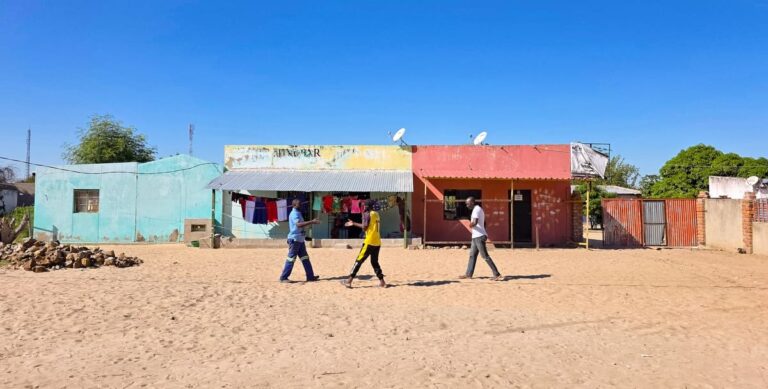
Overlanding from Namibia to Angola was a total wild card. All we really knew was that this southern African country was a Portuguese colony for ~400 years and was embroiled in a decades-long civil war until 2002. We figured we’d get to the border town of Rundu, Namibia, gather some local intel for this Angola trip, and things to do in the neighboring town of Calai…but we couldn’t find anyone who had been over the border! Google Maps made it seem like you had to drive eight hours out of the way to cross the river, and Booking.com pulled up zero results for hotels…this only made us even more curious and eager to explore Southern Angola!
Namibia-Angola Border Crossing at Calai
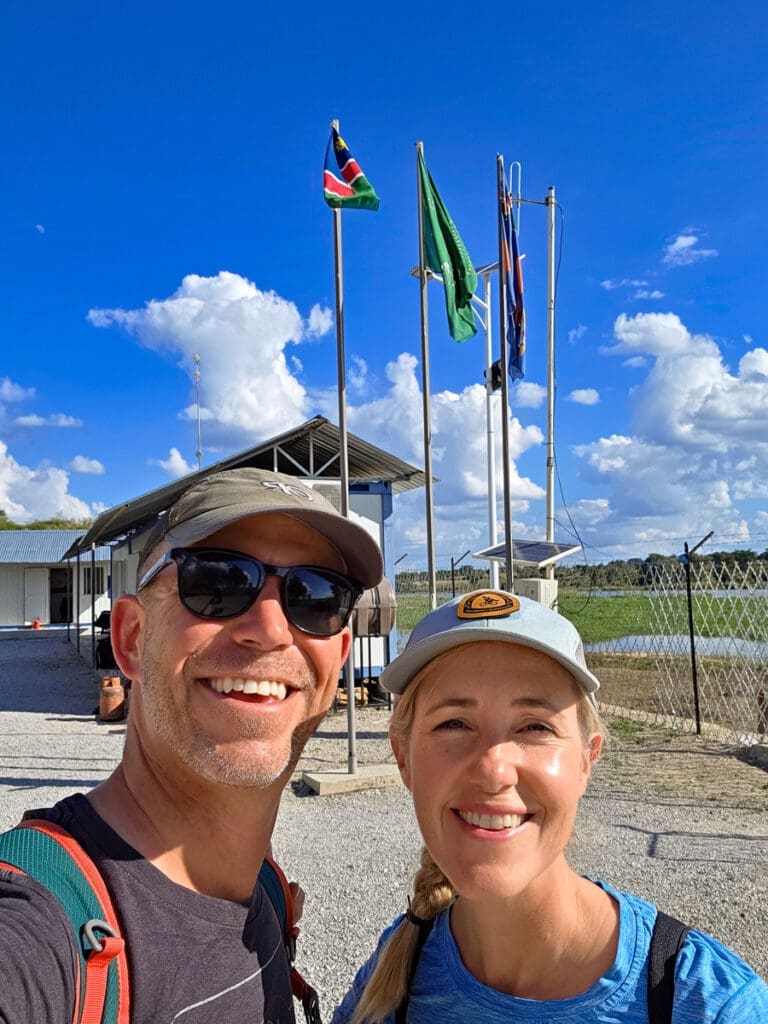
Crossing the footbridge over the Okavango River, we said goodbye to Namibia and ola to Angola. The immigration officer only spoke Portuguese, so in our best Portuñol pidgin, we explained our four-day Angola trip was for “ferias” (holiday purposes) and heard that sweet sound of a stamp hitting our passport. We may have been “in” but with no idea what we were getting into.
A fleet of moto taxis waved us over, so with no cars in sight, Mike and I had no choice but to each saddle up with a stranger and hope we were heading to the same place. Vrrrooom, we zipped through the sandy roads and into central Calai, two streets of shops, an outdoor market, a Portuguese bar…and one guesthouse!
Where to Stay in Calai
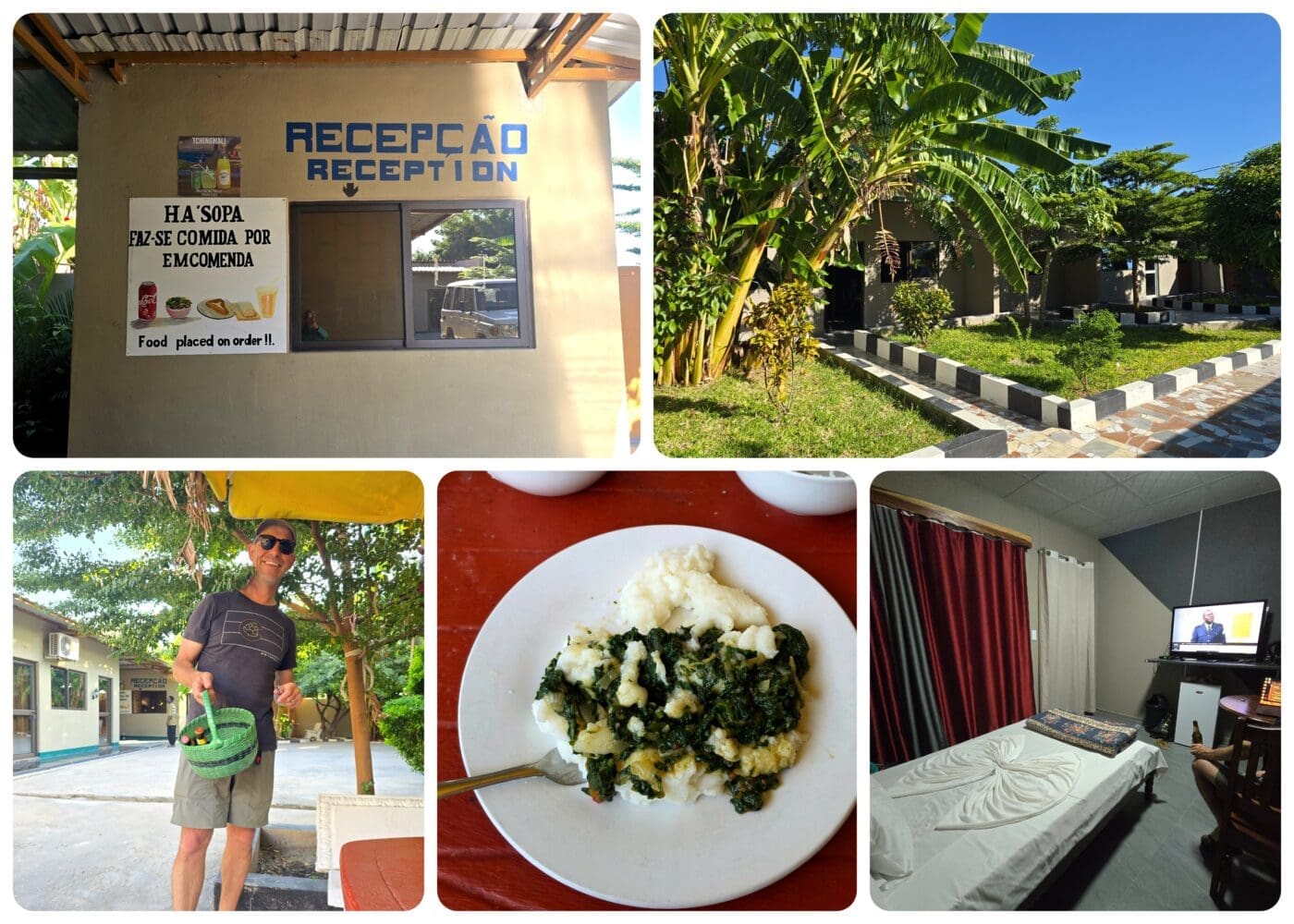
We opened the tall gate to the unassuming Tchingwali Guesthouse, and we were met with a tropical garden, a full restaurant, and pleasant rooms with AC and en-suite baths for $16. Who knew?! As vegans who don’t speak Portuguese, it was a bit hard to figure out the best plant-based option, but an hour and a half later (Africa time is real and it’s even slower in Angola lol), a yummy lunch arrived.
Maize porridge is the basis of most meals in Southern Africa and takes many names (pap, ugali, funge, etc) and is often prepared so it’s dense enough to pick up and scoop the accompanying veg and meat. In Angola, it’s called funge, and we enjoyed ours with sides of wild spinach, peanuts, and slow-cooked beans. We washed it down with a pair of Cuca beers, and ordered another round just because we loved the local custom of cerveja and a bottle opener delivered by wicker basket.
Government Permission to Explore
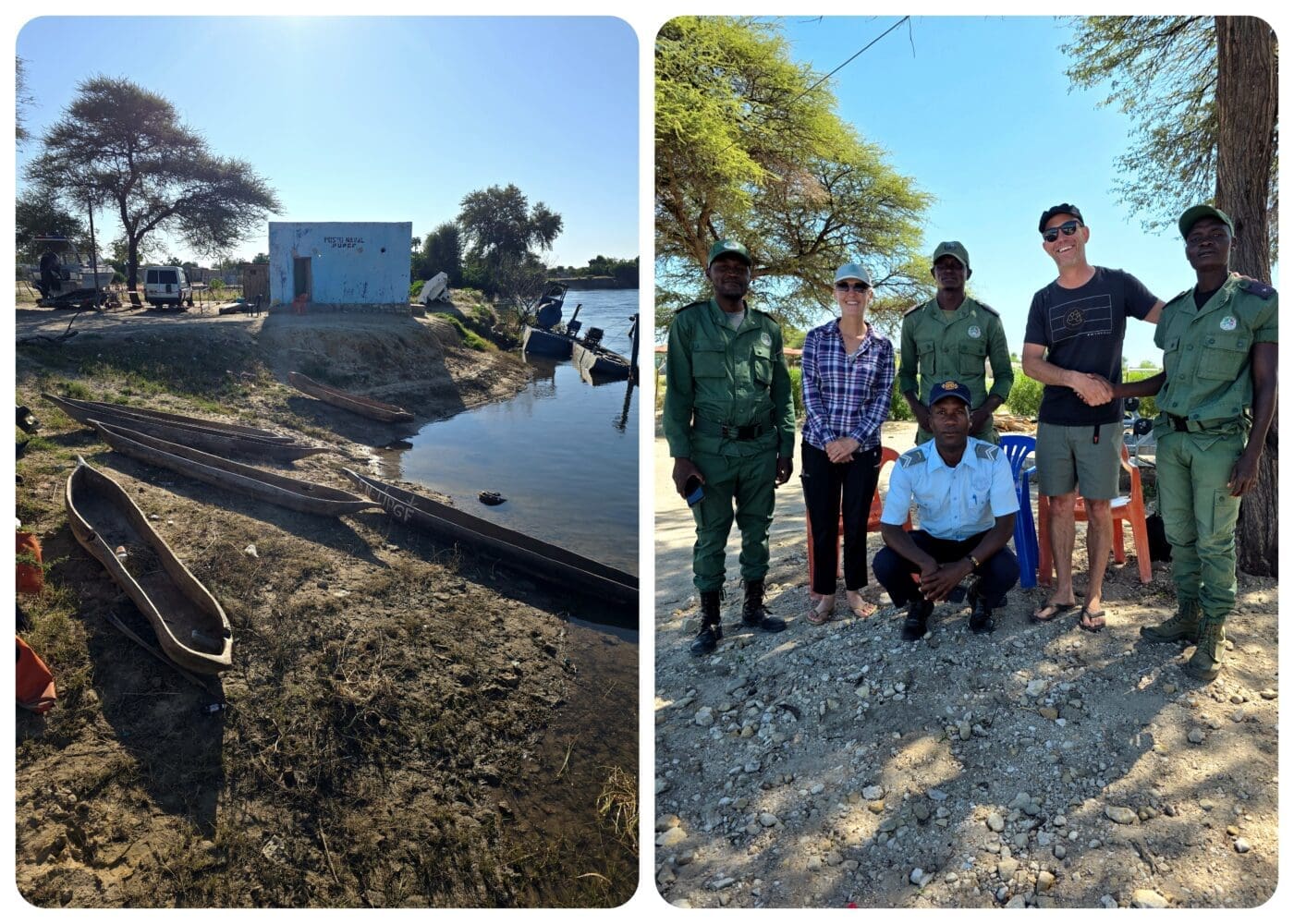
We knew Calai wasn’t a tourist destination, but with the famed Okavango River, we figured there would be some water adventures in our future. We asked our guest house where we could arrange a boat trip, and they said, “Nowhere that we know of, maybe ask by the dock.” They left out the part that the “dock” was actually a naval base, and they weren’t so friendly to unannounced visitors.
After meeting with multiple officers and receiving a long line of questioning (“Are you trying to cross to Namibia? Why do want to canoe if you aren’t fishing? Are you a good swimmer? You know the river is full of crocodiles, right?” ), they warmed up to our idea of a dugout canoe trip with a local fisherman…and they even wanted a selfie to commemorate our trip!
Dugout Canoeing the Okavango River
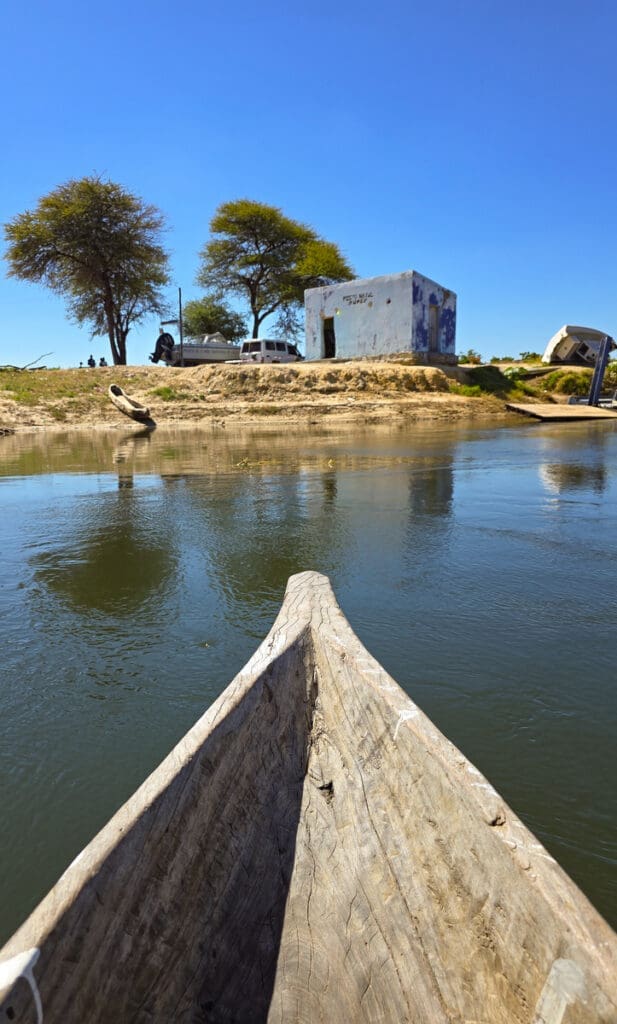
Donning the fire department’s life vests, we joined Segunda for his first foray into river-guiding. He’d never had passengers in his canoe, but he dressed up for the occasion and showed us his favorite eddies, islands, and hippo hiding spots. We tipped him handsomely and shared (the best!) malasada donuts to celebrate what might just become a new chapter in his waterman career. To help make this happen, we introduced him to the Tchingwali Guesthouse team so they could send future guests on an Okavango canoe expedition with the lovely Segunda!
Road Tripping Southern Angola
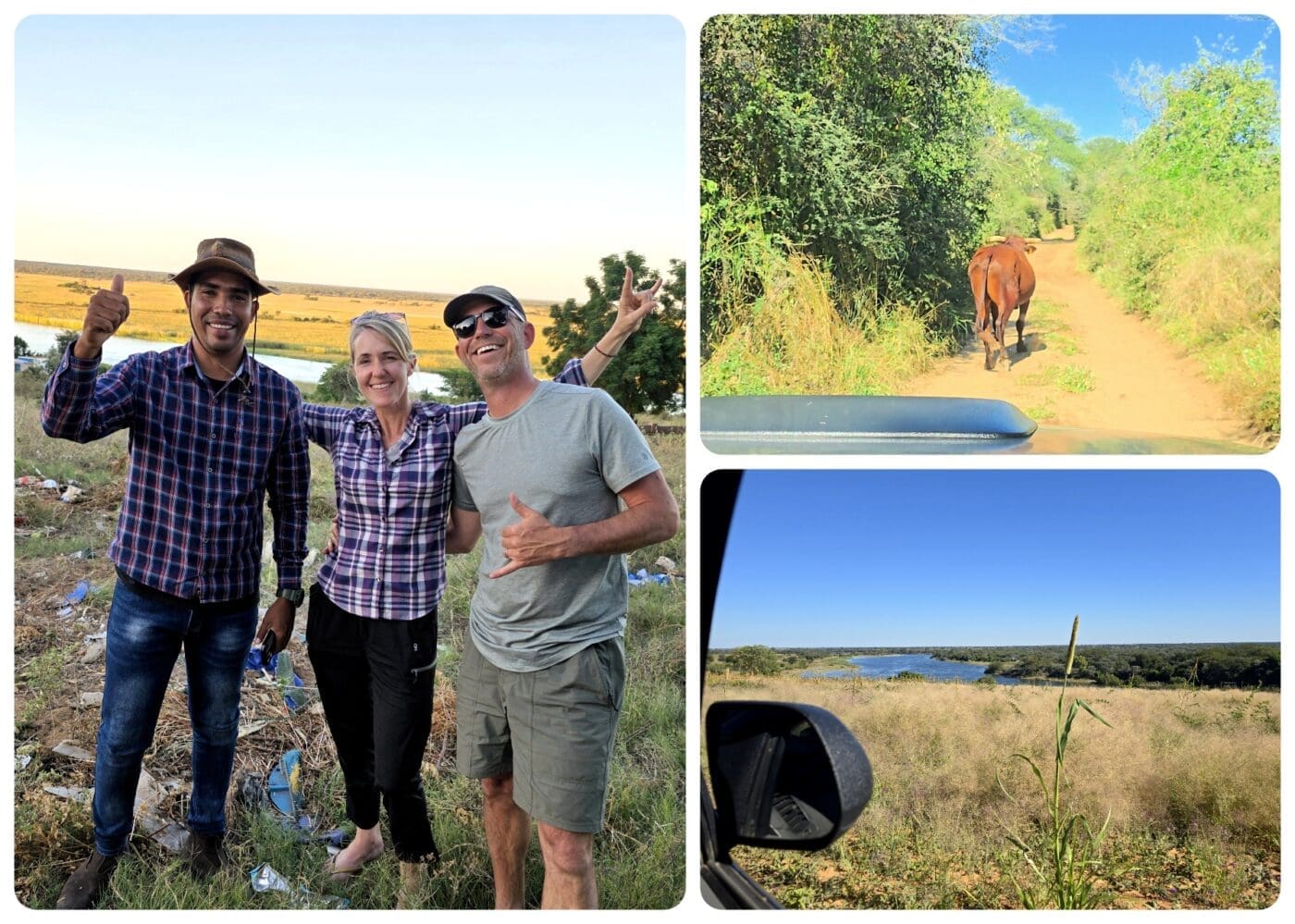
Now to arrange a road trip to explore more of Angola! There were only a handful of non-governmental cars in town, and the best truck happened to be parked at our guesthouse. We went out on a limb and asked the vehicle-owner, Peter, if he’d be willing to show us around the Southern Angola countryside. This unexpected request was met with an even bigger offer to join him the following day on his 120km trip to Dirico with a stop to meet one of the queens of the Cuando-Cubango province.
No crazier than any other idea this trip, we thought, “Heck, why not?!” Off we went on a wild ride down the deep sand roads, cutting through the thick brush. When the bushes opened up, we’d catch glimpses of the mighty Okavango River, the occasional grouping of mud & thatch huts, and fields of pearl millet for a scenic drive.
Visiting with the Queen of Mutango
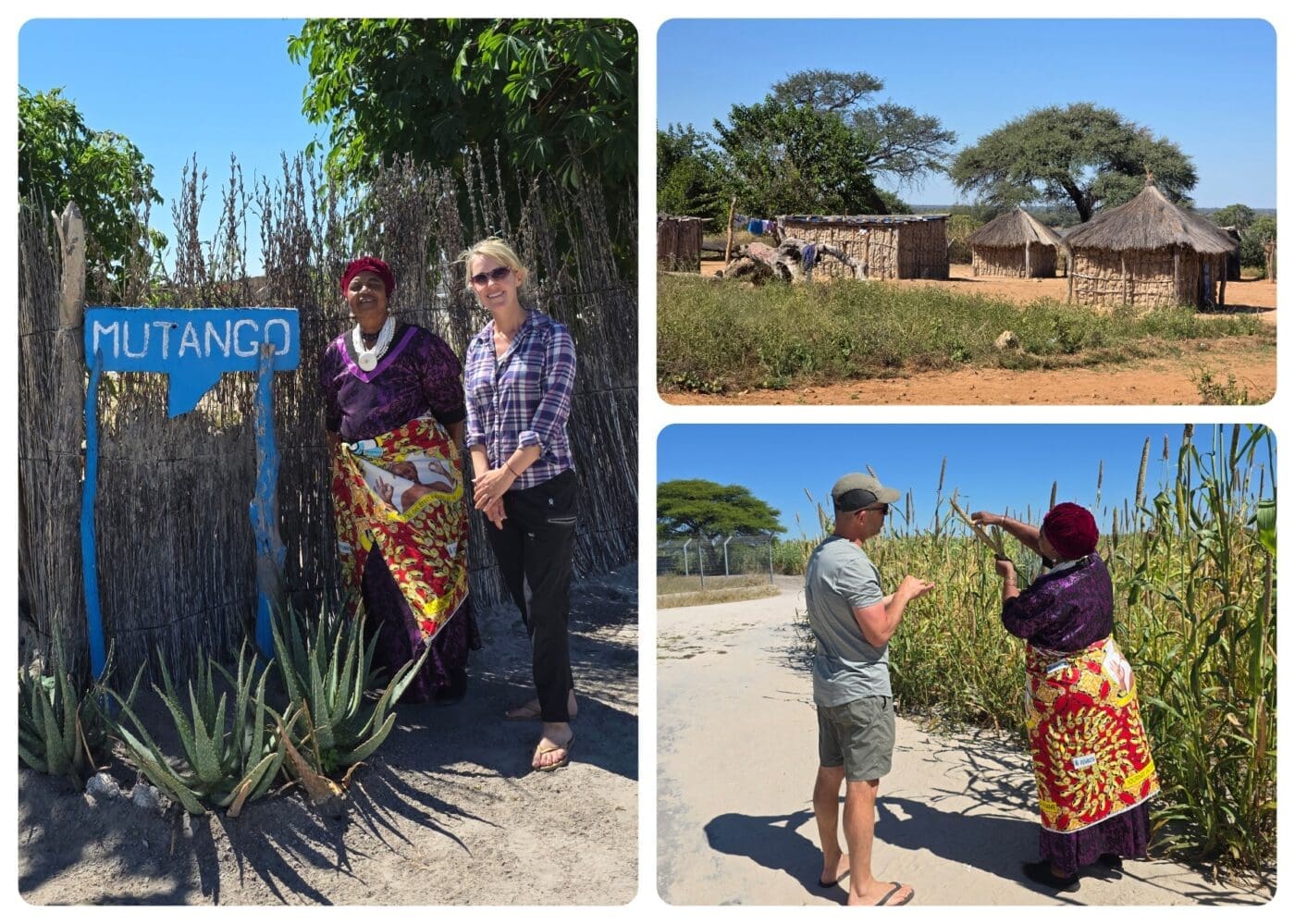
To learn about the local life and agriculture, there was no better person to meet than Queen Katrina! She graciously showed us around her village and farm, and how to shuck and chew sugarcane like the boss she is! Our Angola education continued in the car as I peppered Peter with questions. (I would speak to him in Spanish and he’d respond in Portuguese, and amazingly, we understood each other enough for some deep conversations). During the Angolan Civil War, his dad was a general for the Rebel Party, which was based in this province of Cuando-Cubango.
This area used to be teeming with wildlife, from elephants to lions to giraffes to leopards, but the fighting drove most of them south to the safety of Namibia. Countless landmines still litter the area, and he lamented, Angola still hasn’t quite gotten on its feet, even though the war ended in 2002. Corruption is rife and infrastructure is severely lacking, but you can’t break the spirit of the Angolan people!
Dirico: Where the Rivers Meet

After a four-hour ride down a one-lane sand road, taking countless hits from overgrown bushes and yielding to cows, we arrived in the town of Dirico. Atop a hill where the Cuito River meets the Cubango River, it’s a lovely location and a cheery place. The town square is anchored by its namesake sign and garden with a cute elephant and hippo statue. Adults and kids alike were playing soccer, and we could hear a church choir practicing.
We popped into a market for some food and drinks (the first shop we’d seen all day), and a group of teenage girls swept me up like a long-lost friend. “Selfie, selfie,” they squealed. What started as a photo op turned into an impromptu dance session and laughing fit.
Southern Angola Trip…SOOO worth it!

Before facing the dark and sandy road back to Calai, we took a moment to enjoy the sunset at the bridge over the Cuanavale River. Fishermen hugged the railing and, with just a stick and a line, they were pulling out tiger fish of epic proportions. Kids were cheering with each catch; dinner was served. Peter, Mike, and I cracked our N’gola cervejas, raised our warm beers over the shimmering pink waters, and toasted an unforgettable trip and new friendship.
Angola Trip Tips
Rundu-Calai Border Crossing: From Rundu, it’s a 15-minute cab ride to this remote border post. You’ll process your passport on the Namibia side, then walk across a floating bridge to finish your paperwork in Calai. No visa or entry fee is required.
- Time Change: Note there is a one-hour time difference between Angola and Namibia. In Namibia, borders are open 9am-6pm, and in Angola, the hours are 8am-5pm.
- Language: Portuguese is the official language of Angola, with 47 recognized local languages. There is limited English in Southern Angola, but between that and/or Spanish, people can often understand you if you speak slowly. Since I only know a handful of words in Portuguese, I spoke Spanish with a Portuguese inflection, and it worked pretty well…especially when combined with an offline version of Google Translate’s Portuguese language dictionary! Be sure to download before you go!
- Money: The Angolan Kwanza (Kz) is the national currency and exchanges at 917 Kz to $1 USD. In Calai and Dirico, the Namibian dollar is widely accepted, so we never needed to exchange money. Southern Angola is incredibly affordable, with our hotel running us $15 a night, a meal $2, and a beer $1.
- Connectivity: WiFi and cell reception are hard to come by in Southern Angola. Our T-Mobile Red Unlimited/international plan did not work, but if you have a Namibian SIM card, it should pick up signal from Calai. Best to download maps, currency conversions, and the Portuguese dictionary before you go.
- Transportation: Most people who come to Southern Angola from Namibia arrive by 4×4 overland vehicles for camping adventures. This would undoubtedly be fun and an easier choice, but we’re happy to report that a trip to Calai can be done on foot, by moto-taxi, and by making friends with cars, lol.
We embarked on this Angola trip with zero expectation (and a little bit of jitters) and were met with the pure kindness and unbridled adventure…exactly what we dream of in travel! We hope you too, can take the road less traveled to Southern Angola.

